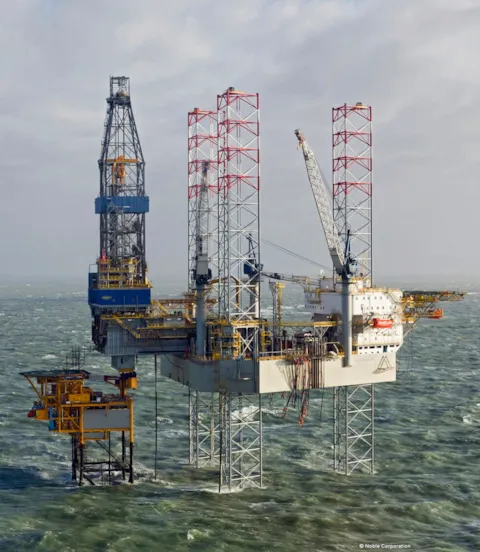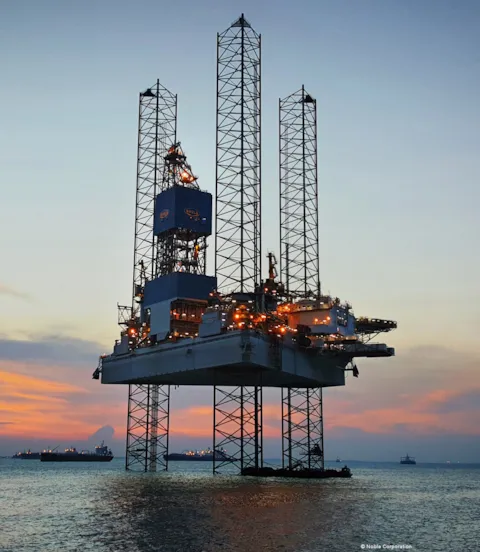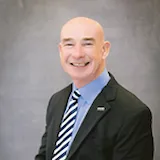Offshore class milestone for DNV GL
A changing market environment along with emerging new opportunities and challenges prompted the drilling contractor Noble Corporation to partner with DNV GL and transfer the class of its self-elevating unit Noble Regina Allen, which coincided with the issuance of DNV GL’s 350th Offshore Class Certificate.
When Noble acquired a fleet comprised largely of units classed by DNV GL in 2010, integrating these vessels into the Noble fleet was the first joint project of the two companies. It marked the beginning of a highly successful relationship. “DNV GL made that process relatively hassle-free. We were able to bring in the assets, continue to class them, make the adjustments necessary, change the documentation/drawings, and shift the engineering over. There was very good teamwork there,” recounts Alan Grodecki, Noble’s Director of Compliance.

Experts in Norwegian drilling
The acquisition was part of Noble’s strategy to extend its mid- and deepwater capabilities. As the company’s business evolved, its demands on its class partners also changed. Deeper waters and higher-spec units require specialized skills. Throughout its 97-year history, seeking out partners with the right competencies has been instrumental to Noble’s success in spite of all market upheavals.
Over the last five years, Noble expanded its DNV GL-classed fleet through an aggressive newbuilding programme which resulted in five deliveries, also classed by DNV GL, from shipyards in Asia: The drillships Noble Don Taylor and Noble Bob Douglas, both delivered in 2013, were followed in 2014 by Noble Tom Madden and Noble Sam Croft, and the world’s largest jack-up rig, Noble Lloyd Noble, in 2016. The drilling contractor chose DNV GL as its classification partner for these units because of its specific technical expertise, says Grodecki: “DNV GL’s quality of service and the level of attention to our needs played a role in our decision to build to DNV GL class at both HHI and Jurong,” he points out. “In addition, our jack-up unit Noble Lloyd Noble was built at Jurong Shipyard in Singapore for operations in the U.K. and Norway. With DNV GL’s strong presence in that region, along with the company’s knowledge about the requirements and what we had to do during the construction and review process, the decision to partner with DNV GL in 2013 made a lot of sense.”
Another strategic investment was the massive training centre Noble built in Sugar Land, Texas, in 2013, called NobleAdvances. The state-of-the-art facility, equipped with 3D simulators for delivering technical expertise training and team development, teaches everything from drilling fundamentals and well control to marine and subsea skills, including dynamic positioning.
Setting higher standards in safety and environmental protection
When oil prices fell in recent years and the oil and gas industry felt a painful squeeze on its cash flow, the challenge for Noble and its peers was to adapt and optimize their performance to remain profitable while maintaining a long-term investment and operating outlook. Significant layoffs were among the harsh consequences. Compared to the boom years, Noble is currently running a much leaner operation, requiring the company to be more strategic about where to invest its time and resources. “Times are a bit depressed right now. In certain areas, we are really trying to hang on to the progress that we had made in the last ten years,” comments Scott Marks, Senior Vice President of Engineering. Regarding the training centre, however, he stresses: “While it is an expense, we’re hanging on to it because we really see value in it. It is an investment in our personnel, which means: an investment in our business.”
The imbalance of rig supply and demand has stoked fierce competition amongst drillers. Noble has made significant advances in its management systems in an effort to standardize processes, gain efficiencies and differentiate itself in the market. “We have developed a lot of processes around safety and environmental protection,” says Marks. “We hold ourselves accountable to a higher standard. This serves well with our customers, who are mostly the Oil Majors, but we also feel that it’s our duty as a company.”
DNV GL provides certification to the International Safety Management (ISM) Code, certifying all Noble rigs that are required to have a Safety Management Certificate, all of the offices that are required to have a Document of Compliance and all of the ships that are required to have a ships security certificate, regardless of the class provider for the unit. Noble also holds ISO 14001:2015 certification from DNV GL. This broad range of certification activities for Noble provides DNV GL with an opportunity to develop a deep understanding of Noble’s culture as it pertains to safety and environmental stewardship and to deliver superior services.

Comprehensive support to gain a Certificate of Fitness
In 2017, ExxonMobil awarded Noble a plug and abandonment (P&A) contract for the Sable Offshore Energy Project. The 22-well P&A programme would involve the relocation of the jack-up Noble Regina Allen from Scotland to the waters just off the east coast of Nova Scotia, Canada, where it would be used to set mechanical and concrete plugs in strategic locations within the wellbore to permanently seal the wells.
In Nova Scotia, however, no petroleum-related exploration, development or transport activities can be conducted without specific authorization from the Canada-Nova Scotia Offshore Petroleum Administration Board (CNSOPB). For ExxonMobil to proceed with the programme, Noble Regina Allen needed a Certificate of Fitness (COF) issued by a certifying authority stating that it was fit for purpose.
Noble reached out to DNV GL to discuss the need for the COF. Grodecki explains: “We knew DNV GL had offices in Canada, with knowledgeable, experienced professionals who had dealt with Certificates of Fitness for other rigs. We did not have any experience in this COF, so we were eager to partner with someone who did.” After submitting detailed guidance on the efforts necessary to obtain the certificate, DNV GL was quickly selected as the right partner for the project.
DNV GL specialist surveyors from Canada travelled to Aberdeen to visit the rig and carry out a full GAP assessment against the CNSOPB regulations for issuance of a COF. The resulting comprehensive gap analysis report included an in-depth summary of regulatory compliance, identification of standard and high-risk regulatory queries (RQ) and physical non-compliances to the regulations. The report also detailed necessary corrective action and major modifications, documentation to be provided and surveying and testing requirements to meet all the necessary regulations. Two major gaps relating to the winterization of the unit and the addition of a lifeboat were identified during the initial survey. DNV GL’s resources from the UK worked in close collaboration with DNV GL’s Canadian experts to support Noble in the process of completing the modifications needed. Upon successful completion of the work ahead of schedule, Noble Regina Allen was issued a COF in record time.
While DNV GL was carrying out the surveys for the COF, the special class survey became due. Noble recognized that there were efficiencies to be gained by having the COF and class services provided by the same party. Having been impressed with the speed and quality of the support received from DNV GL on the COF, Noble elected to transfer the class of the unit to DNV GL as well.

Veracity platform provides key data
In an effort to further differentiate the company from the competition and take advantage of advances in technology, Noble embarked on its own digital journey, developing a number of new innovative technologies to seize major opportunities for the future.
“One of the projects that we have been working on is the eBOP™: an innovative design where the rams or actuators of the blowout preventer (BoP) are operated by motors,” describes Grodecki. Traditional BOPs have hydraulic lines going all the way to the surface. “There are a host of design advantages with the eBOP™. For instance, the use of the motors provides an immediate response when you send a command to the BOP, thereby giving you immediate feedback. We have invited DNV GL to look at our design and may have this approved.”
Noble has also partnered with DNV GL for a pilot project which involves the integration of data from DNV GL’s Veracity platform to Noble’s Power BI Dashboard. “We use the data provided by DNV GL, along with data from other sources, to get a real-time status of our rigs. We have better visibility of things like the expiration of certificates or class conditions, as it relates to all parts of organization and all of our units,” comments Grodecki.
As Noble looks to the future, Marks sees that DNV GL is in a strong position to support the company and that DNV GL and Noble share similar ideals when it comes to digitalization and innovation. “With the downturn in the offshore industry, everyone has had to cut back on resources, including class societies. Personally, I appreciate that DNV GL is trying to leverage technology to maintain the same level of service, and, for the most part, I see that the mission has been successful. We are very pleased with the value we receive from DNV GL. It’s been a great partnership,” Scott Marks summarizes.
